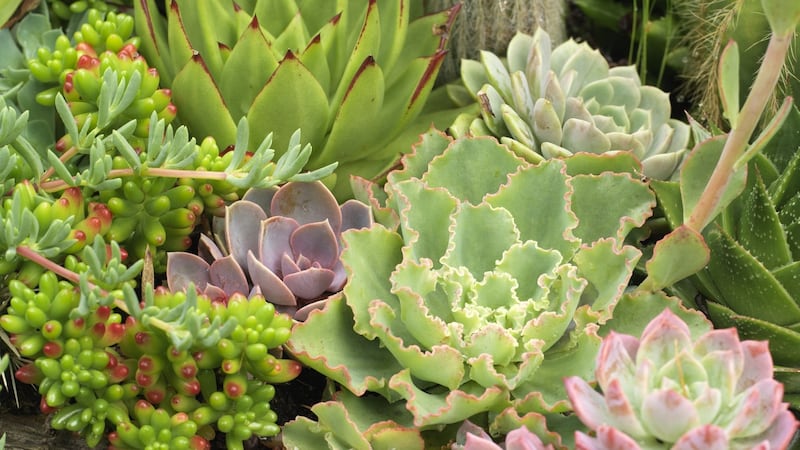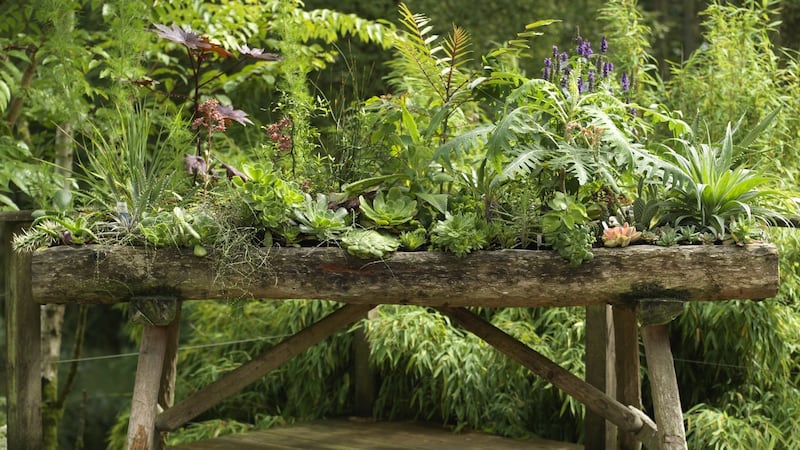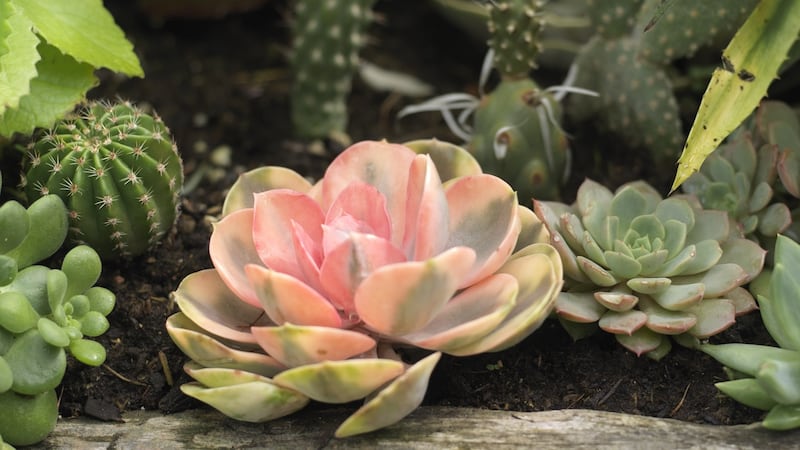Some are plump and fleshy, others spiny and spiky, often with flamboyant flowers. But it’s the beauty of their intricately sculptural, elaborately arranged, long-lasting, colourful leaves - especially when combined with these plants’ impressive ability to withstand prolonged periods of drought - that has made succulents so fashionable in recent years.
Peruse the pages of the latest style bible or trendy blog and you'll see succulents in quirky containers decorating the windowsills of hip apartments, or being used to make elaborate 'microscapes', or to embellish everything from jewellery (check out the fascinating Instagram feed of @passionflowersue ) to bouquets, wreaths and even furniture.
Part of their great charm is the fact that these fleshy plants are happy to grow indoors in almost any sort of pot or container, from a simple shallow bowl to recycled wine boxes or vintage suitcases, making them a great choice for green-fingered flat-dwellers with little or no growing space. All they ask for is plentiful sunlight (although a few including the haworthias, gasterias and some varieties of aeonium are even happy in light shade), a free-draining compost and that you go extremely easy on the watering, especially in winter.

Most succulents are natives of the hottest, most arid regions of the world and so they won’t survive our average damp, cool Irish winter outdoors. Those few that can include the highly ornamental houseleek or sempervivums, whose evergreen, ground-hugging rosettes look wonderful planted into a stone trough, alpine bed or into the cracks between paving stones or between the crevices of an old stone wall. Just make sure that whatever spot you give it is in full sun and that the soil is sharply drained and no more than moderately fertile.
Much larger succulents suitable for mild Irish gardens when given the right growing conditions - again, sharply-drained, moderately fertile soil and full sun- include some species of the spiny agave (Agave americana, Agave parryi, Agave gentryi ), the statuesquely spiky Beschorneria yuccoides, as well as species of furcraea, puya, yucca and dasylirion.

But for those gardeners with limited outdoor space, it’s the countless kinds of tender succulents that are particularly beguiling. Take the tiny lithops, the ‘living stone’ plant so named because it looks for all the world like a pretty pebble. Or the echeveria, whose fleshy leaves are arranged in tight rosettes that exhibit complex fractal patterns and are as beautiful as any garden rose. Or the aeonium, which has ornately-arranged and colourful, fleshy leaves in shades of bronze, gold, rust, plum, the darkest of them all being the sooty-leaved cultivar known as ‘Zwartkop’.
The same goes for the many varieties/hybrids of crassula, haworthia, graptopetalum, pachyphytum, and pachyveria. Planted in artful combinations that highlight their contrasting sculptural forms and colours, the result is a long-lasting, low-maintenance, space-efficient indoor plant display. Alternatively, try growing some of the trailing kinds as indoor plants in hanging-pots. Species/varieties suitable for this purpose include Senecio herreianus, commonly known as ‘String of Pearls’, and Sedum morganianum , commonly known as ‘Donkey’s Tail’.
Again, all of these plants require bright light, good ventilation, minimal watering and the sort of sharp drainage that mimics their natural growing conditions. So add plenty of sharp horticultural grit or perlite to aerate the compost you’re using- ideally 3 to 4 parts grit/perlite to 6 to 7 parts compost- while making sure that the container has sufficient drainage holes at its base to allow any excess water to quickly drain away. During the summer months, you can move the entire display outdoors if you want to.
In fact, this is exactly what succulent enthusiast Jimi Blake of Hunting Brook gardens in West Wicklow does with his extensive collection of succulents, most of which he grows in two large, rustic wooden troughs raised to table-height so he can enjoy the plants’ ornate beauty close up. He then moves them all back indoors again before the first autumn frosts arrive, arranging/replanting them in highly decorative combinations into large, shallow trays that he places near a bright upstairs window. "This way, I get to enjoy them all year round."

Blake sources most of his plants from UK-based online suppliers Surreal Succulents (surrealsucculents.co.uk) and the Dublin-based specialist nursery Harrington’s Exotics, whose owner Michael Harrington is a regular exhibitor at the ISNA shows that take place around the country during the summer months. Harrington, who also opens his nursery to interested customers by prior appointment (see isna.ie for contact details), is full of useful tips on looking after succulents in our cool, damp Irish climate.
"The two classic mistakes are overwatering or underwatering. Most succulents should be watered only minimally during the winter months, but that doesn’t mean ‘don’t water them at all’. He also advises giving pot-grown plants a monthly potash-rich liquid feed from April to September and regularly repotting them so that they don’t run short of nutrients.
"His last words of advice are to avoid those with evil –scented flowers designed to attract specific pollinators. “For example, the flowers of stapelias and hoodias smell of rotting meat to attract blowflies. You wouldn’t want one of those in the house…”
[ irelandcactus.comOpens in new window ]

This Week in the Garden
• Early September is the best time to cut back native perennial wildflower meadows as the plants will have had time to set seed. With garden-sized meadows, it’s possible to do this using a scythe or strimmers. Leave the cut material on the ground for a few days to allow any remaining ripe seed to spill before collecting it, then vigorously rake the ground to help the freshly-fallen seed to make contact with the soil. Now is also the best time to sow freshly-harvested seed of yellow rattle, the hemi-parasitic native annual plant that’s key to reducing the populations of coarse grasses, thus enabling a wide range of less vigorous meadow species to grow
• September is a good month to sow lawn seed, as the soil is still warm but unlikely to dry out during a hot spell, giving the perfect conditions for good seed germination. Make sure to prepare the soil very well in advance by carefully removing any lumps, stones or debris, leveling off any bumps or hollows and raking the soil to a fine, crumbly tilth. Lawn seed is available from most good Irish garden centres and in a range of species/ varietal mixes designed to suit different growing conditions and intensity of use.
• Cut back the old canes of summer raspberries that have finished fruiting, using a sharp secateurs/loppers to slice them away at ground level. The new canes (these look fresh and green in comparison to the old, faded canes) should then be tied in to strong horizontal wires/netting , which should be supported by sturdy posts. This sort of late summer/early autumn pruning encourages the production of strong, vigorous, productive canes next year.
Dates For Your Diary
Sunday 3rd September (from 11.30am): Kilruddery House, Bray, County Wicklow, 'Totally Terrific Tomato Festival' with displays, competitions, and talks by guest speakers including champion vegetable grower Medwyn William, tomatophile Nicky Kyle and Dr Matthew Jebb, Director of the National Botanic Gardens, see kilruddery.com.
Also on Sunday 3rd September (2pm and again at 5pm): Patthana Gardens, Kiltegan, County Wicklow, talk and tour of this excellent small garden by owner TJ Maher, garden open to the public 12-6pm.
Sunday 10th September (9.30am-4.30pm): Irish Agricultural Museum, Johnstown Castle, County Wexford, Killinick & District Annual Garden Show.
Also on Sunday 10th September: Clargegalways Autumn Garden & Food Fair in Claregalway Castle, with plant sales by many of Ireland leading specialist plant nurseries, see claregalwaycastle.com
Saturday, September 9th to Tuesday September 17th: Mount Venus Nursery, Mutton Lane, Rathfarnham, Dublin 16, 'A Different Perspective', a photography exhibition by Liat Schurmann, garden designer and co-founder of Mount Venus Nursery












